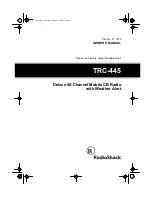
LBI-38435B
8
There are five (5) different optional interchangeable
control panels available for selecting a two channel radio,
an eight (8) or sixteen (16) channel radio. The five
control panels are as follows:
•
Optional MK1J:
Two (2) Channel
without Scan (19A705800P100)
•
Option MK1L:
Eight (8) Channel
without Scan (19A705800P101)
•
Option MK1N:
Eight (8) Channel
with Scan (19A705800P102)
•
Option MK1P: Sixteen (16) Channel
without Scan (19A705800P103)
•
Option MK1R: Sixteen (16) Channel with
Scan (19A705800P104)
Optional Control Panels 19A705800P100 thru P104 are
for use in MLS radios 19A705800P1 thru P7 ONLY.
They are NOT compatible with the 19A704991() series
MLS radios. MLS radios 19A704991P1 thru P7 use
Control Panels 19A704991P101 thru 19A704991P104
ONLY.
CAUTION
Microphone
The mobile radio uses a dynamic microphone with a
built-in transistorized pre-amplifier. The microphone is
housed in a sturdy case and the extendable coiled cord
plugs into a jack provided at the back of the radio. The
microphone is secured to the radio by means of a strain
relief hook on the microphone cable.
Hookswitch
A hookswitch is provided with the radio to hold the
microphone. Removing the microphone from the
hookswitch disables the Channel Guard, enabling the
operator to monitor the channel before sending a message.
Removing the microphone while in the SCAN mode will
also disable SCAN until the microphone is placed back
into the hookswitch.
Channel Guard
Channel Guard provides a means of restricting calls
to specific radios through the use of a continuous tone or
digitally coded squelch system (CTCSS or DCG). Tone
frequencies range from 67.0 Hz to 210 Hz. 33 standard
tones and 104 unique digital codes are available.
Carrier Control Timer
The Carrier Control Timer turns off the transmitter
after the microphone push-to-talk (PTT) switch has been
keyed for a pre-programmed time period. The timer can
be programmed to time out and sound an alert tone in 30
second increments up to 7.5 minutes.
External Speaker (Optional)
An optional 4-Watt, 4-ohm external speaker is
available for use with the radio. The speaker is supplied
with a mounting bracket and mounting hardware. The
speaker leads connect through connector J701 on the back
of the radio (refer to applicable Installation Manual).
Programming
The EEPROM allows the radio to be programmed or
reprogrammed, as needed, to adapt to changing system
requirements. RF frequencies, Channel Guard tones,
digital codes, and CCT can be reprogrammed. The
EEPROM is programmed through the radio MIC
connector J701, using an IBM compatible PC and special
cable. Programming instructions are provided in the
respective Programming Manual.
OPERATION
This section provides a description of the Control and
Indicator functions as well as the basic procedures for
transmitting and receiving messages. Complete operating
instructions for the radio are provided in the respective
Operator’s Manual.
CONTROLS
The radio control panel contains the VOLUME
control, the POWER on/off switch, the MONITOR
switch, and the CHANNEL select switch. The switch
functions are as follows:
POWER
A momentary type switch to turn the
radio on or off. Press once to turn the
radio on; press again to turn the radio
off. Power ON is indicated by an
illuminated channel number on the
system module.
VOLUME
Two momentary type switches to adjust
the volume. Press and hold the MAX
(up arrow) to increase the volume.
Press and hold the MIN (down arrow)
to decrease the volume.
.
Summary of Contents for LBI-38435B
Page 7: ...LBI 38435B 7 Figure 1 MLS Mobile Two Way FM Radio ...
Page 15: ...INTERCONNECTION DIAGRAM LBI 38435B 15 ...
Page 16: ...LBI 38435B ILLUSTRATED MECHANICAL PARTS BREAKDOWN 16 ...
Page 17: ...MECHANICAL PARTS LIST LBI 38435B 17 ...
Page 18: ...INTERCONNECTION KIT LBI 38435B 18 ...
Page 19: ...LBI 38435B 19 This Page Intentionally Left Blank ...







































